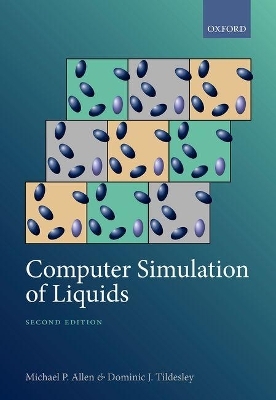
Computer Simulation of Liquids
Oxford University Press (Verlag)
978-0-19-880319-5 (ISBN)
This book provides a practical guide to molecular dynamics and Monte Carlo simulation techniques used in the modelling of simple and complex liquids. Computer simulation is an essential tool in studying the chemistry and physics of condensed matter, complementing and reinforcing both experiment and theory. Simulations provide detailed information about structure and dynamics, essential to understand the many fluid systems that play a key role in our daily lives: polymers, gels, colloidal suspensions, liquid crystals, biological membranes, and glasses. The second edition of this pioneering book aims to explain how simulation programs work, how to use them, and how to interpret the results, with examples of the latest research in this rapidly evolving field. Accompanying programs in Fortran and Python provide practical, hands-on, illustrations of the ideas in the text.
Michael Allen obtained his first degree, and doctorate, in Chemistry at the University of Oxford. After post-doctoral positions at UCLA and Oxford, he was, in 1985, appointed Lecturer, then Reader, and finally Professor in Physics at the University of Bristol. In 2001 he became founding Director of the Centre for Scientific Computing in Warwick, where he stayed in Physics until retirement in 2014. Allen was awarded an Alexander von Humboldt Foundation Forschungspreis in 1999, visiting Mainz (University and MPI for Polymer Research). He received the 2015 Lennard-Jones award and lectureship from the Royal Society of Chemistry Statistical Mechanics and Thermodynamics Group, and the Thermodynamics Conference series. Dominic Tildesley obtained his first degree at the University of Southampton, and his doctorate in Chemistry at the University of Oxford. After post-doctoral positions at Penn State and Cornell, he was appointed Lecturer, then Reader, and Professor in Chemistry at the University of Southampton. In 1998 he became Head of Physical Sciences at Unilever Research and Development, Port Sunlight and in 2004, Chief Scientist of the Home and Personal Care Division. In 2013, he was appointed as Director of the Centre Européen de Calcul Atomique et Moleculaire at the EPFL in Switzerland. Tildesley was awarded the Marlow and Tilden medals of the Royal Society of Chemistry and a CBE for services to science, technology and business.
1: Introduction
2: Statistical mechanics
3: Molecular dynamics
4: Monte Carlo methods
5: Some tricks of the trade
6: Long-range forces
7: Parallel simulation
8: How to analyse the results
9: Advanced Monte Carlo methods
10: Rare event simulation
11: Nonequilibrium molecular dynamics
12: Mesoscale methods
13: Quantum simulations
14: Inhomogeneous fluids
App. A Computers and computer simulation
App. B Reduced units
App. C Calculation of forces and torques
App. D Fourier transforms and series
App. E Random numbers
App. F Configurational temperature
| Erscheinungsdatum | 17.08.2017 |
|---|---|
| Zusatzinfo | 93 greyscale line figures |
| Verlagsort | Oxford |
| Sprache | englisch |
| Maße | 179 x 252 mm |
| Gewicht | 1366 g |
| Themenwelt | Mathematik / Informatik ► Informatik ► Theorie / Studium |
| Naturwissenschaften ► Physik / Astronomie ► Angewandte Physik | |
| Naturwissenschaften ► Physik / Astronomie ► Strömungsmechanik | |
| Naturwissenschaften ► Physik / Astronomie ► Thermodynamik | |
| ISBN-10 | 0-19-880319-2 / 0198803192 |
| ISBN-13 | 978-0-19-880319-5 / 9780198803195 |
| Zustand | Neuware |
| Haben Sie eine Frage zum Produkt? |
aus dem Bereich


